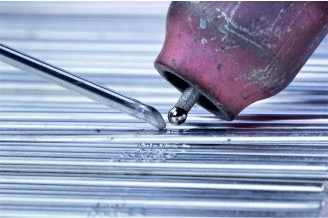
ERCuSn-C (also known as S213, SCu5210, etc.) is a phosphor bronze welding wire widely used in welding and overlaying specific metals due to its excellent performance. Below, I will provide a detailed introduction to the characteristics, applications, handling tips, and relevant standards of ERCuSn-C welding wire.

ERCuSn-C welding wire is a tin-phosphor bronze welding wire with the following characteristics:
Chemical Composition (%):
Tin (Sn): 7.5–8.5% (High tin content improves hardness and wear resistance)
Phosphorus (P): 0.01–0.4% (Deoxidizer, reduces porosity, but excessive amounts can increase hot brittleness)
Copper (Cu): Balance
Other trace elements (such as Fe, Zn, and Pb) should be kept to low levels.
Physical and Mechanical Properties:
Density: Approximately 8.8 kg/dm³
Melting Temperature Range: 875–1025°C
Electrical Conductivity: 10–14% IACS
Thermal Conductivity: 67 W/m·K
Mechanical Properties (Reference Values for Deposited Metal):
Tensile Strength: 260–320 MPa
Elongation: 20%
Hardness: 80–90 HB
Impact Toughness: 28 J
High tin content improves the hardness, strength, and wear resistance of the deposited metal, but also increases the tendency to hot brittleness (crack sensitivity at high temperatures) during welding, necessitating strict control of the welding process.

ERCuSn-C welding wire is commonly used in the following applications:
Jointing of similar metals:
For example, welding of copper (red copper) and phosphor bronze components.
Jointing of dissimilar metals:
Jointing of brass and steel: Produces strong joints.
Repairing of cast iron: Repairs defects in copper or iron castings.
Surface Hardfacing:
Welding is performed on steel or cast iron surfaces to improve wear resistance, corrosion resistance (such as seawater resistance), or to repair worn parts.
Pulsed TIG welding is particularly recommended for multi-layer cladding on steel to reduce heat input and distortion.
Brazing: Can be used for furnace brazing of steel.

To achieve high-quality welds, the following precautions should be taken:
Welding Method:
Gas tungsten inert gas (TIG) welding is the most commonly used method.
When cladding steel, pulsed TIG welding is recommended for better heat control.
Preheating Requirements:
For thick workpieces or certain materials (such as steel), preheating (typically 200-300°C) is necessary to prevent cracks and reduce porosity.
Process Control:
Maintain a small weld pool: Use low current and fast welding speeds to avoid overheating to reduce the tendency to hot brittleness.
Groove Design: A V-groove is typically used.
Welding Position: Welding in the flat position is generally recommended.
Shielding Gas: High-purity argon gas is used for shielding to ensure good gas shielding and avoid weld oxidation and porosity.

ERCuSn-C welding wire complies with multiple international standards, with slightly different grades depending on the standard:

Table: Corresponding grades of ERCuSn-C welding wire in different standards

When using ERCuSn-C, be aware of its limitations:
Hot brittleness: This is an inherent characteristic of high-tin phosphor bronze welding wire and must be mitigated through strict process control (low heat input, preheating).
Porosity Sensitivity: Sensitive to moisture and oil, requiring thorough cleaning of the base metal and wire before welding.
Position Restrictions: Typically limited to flat welding, limiting its applicability to certain complex structures.

ERCuSn-C (S213) phosphor bronze welding wire is a high-performance copper alloy welding consumable. Its excellent wear resistance and strength make it an excellent choice for joining copper alloys to steel, repairing castings, and performing hardfacing welds.
However, its tendency to hot brittleness requires welders to possess excellent process control and strictly adhere to preheating, low current, fast welding speeds, and flat welding position specifications. When selecting a grade, be sure to verify the grade against the project standards (such as AWS, GB, etc.).5

